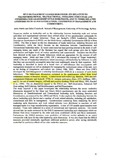| dc.description.abstract | Numerous studies on leadership and on the relationship between leadership style and various
individual and organisational outcomes have utilised either of two questionnaire instruments for
the measurement of leader behaviour. These are StodgiIl's (1963) Leadership Behaviour
Description Questionnaire (LBDQ), and the Multi-factor Leadership Questionnaire (MLQ) of Bass
(1985). The first is based on the two dimensions of leader behaviour, Initiating Structure and
Consideration, while the MLQ focuses on the distinction between Transformation and
Transactional leadership styles. 1n recent years there has been growing interest in the study of selfmanaging teams, and much of the literature has argued that such groups give rise to higher
performance and higher levels of worker satisfaction and commitment. Attention has therefore
been directed at the types of leader behaviours which are appropriate for the success of self-managing teams. Manz and Sims (1989, 1991) introduced the concept of "Super leadership",
which is the set of leadership behaviours which encourages self-leadership by followers in order
that they can successfully accomplish tasks that were traditionally done by their superiors. Self-leadership is described in terms of a broad view of self-influence that encompasses self-management strategies as well as strategies for managing the motivational values of the task, such
as the feeling of competence, self-control, etc. (Manz, 1986, 1992). Manz and Sims (1987)
developed the Self-Management Leadership Questionnaire (SMLQ) as a measure of such leader
behaviours. The behavioural dimensions contained in the questionnaire reflect three broad
established streams of literature, namely, 1) behavioural self-control (eg. Bandura, 1969) and selfmanagement (Mahoney and Amkoff, 1978); 2) intrinsic motivation (Deci, 1975; Hoffman, 1981),
and 3) the use of mental imagery, self-talk and positive thinking (Neck and Manz., 1992; Kendall
et al., 1990). The six dimensions tapped by the SMLQ are: Self-observation, Rehearsal, Self
Goal-setting, Self Criticism, Self Reinforcement, and Self Expectation.
The study reported in this paper investigates the relationship between the newer leadership
dimensions measured by the Manz and Sims's SMLQ questionnaire and the more established
dimensions of Transformational and Transactional leadership style, Initiating Structure and
Consideration, as measured by the LBDQ and MLQ. It also explores the relationship between the
above leadership style factors and a number of work related attitudes, including job satisfaction,
commitment and faith in management. Questionnaires containing items measuring the above
leadership style dimensions and work related attitudes were distributed to members of selfmanaged
teams in a large manufacturing organisation. A total of 318 useable questionnaires were
returned. These were subjected to a series of correlational and regression analyses. The results
showed that the scales measured by the SMLQ represented leadership style dimensions which are
distinct from those measured by the older and more established LBDQ and MLQ instruments.
Furthermore, the SMLQ measures were predictive of follower worker attitudes to an extent
comparable with those for the older leadership style dimensions. It was also found that the SMLQ
measures provided statistically significant additional predictive power after having statistically
controlled for predictive effects of the older leadership measures. | en_UK |


